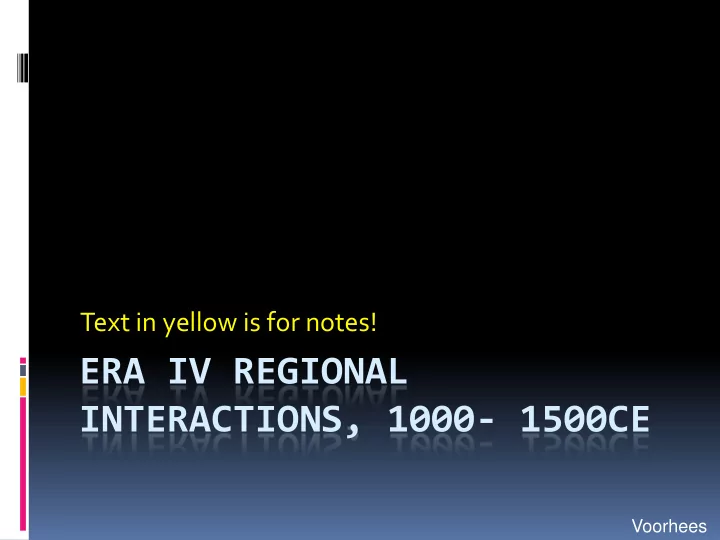

Text in yellow is for notes! ERA IV REGIONAL INTERACTIONS, 1000- 1500CE Voorhees
Era IV Study Guide Reading Activity 1. Read each SOL strand 2. Highlight essential content 3. Be able to understand what they are asking you to know 4. Simplify… be able to say it in your own words…
Unit WHI.11 Eastern Hemisphere; Asia 1000- 1500CE
The student will apply social science skills to understand the civilizations and empires of Asia, with emphasis on Japan and China, by a) locating and explaining major global and regional trade routes
What would you name these major trade patterns? A. ____________________________________________________ B. ____________________________________________________ C. ____________________________________________________ D. ____________________________________________________ E. ____________________________________________________ F. ____________________________________________________
Now see if you can draw the routes by your descriptions:
The student will apply social science skills to understand the civilizations and empires of Asia, with emphasis on Japan and China, by b) explaining technological advances and transfers, networks of economic interdependence, and cultural interactions
I. Regional Trade: Regional trade networks and long-distance trade routes in the Eastern Hemisphere aided the diffusion and exchange of technology and culture between Europe, Africa, and Asia A. Trade routes 1. Diffusion (spread) and exchange of technology and culture 2. The six to know:
Draw these 6 main trade routes on your Eastern Hemisphere map
Traditional trade patterns linking Europe with Asia and Africa a) Trans-Saharan routes across North Africa b) Western European sea and river trade c) Northern European links with the Black Sea d) Silk roads across Asia to the Mediterranean basin e) Maritime routes across the Indian Ocean South China Sea and lands of Southeast Asia f) B. These routes link Europe, Asia, and Africa
II. Technology: A. Medicine, astronomy, mathematics B. China: 1. Paper, compass, silk, porcelain 2. Printing and paper money C. India and Middle East: Textiles, numeral system
China= making paper Making paper for 500 years- and nobody knew! Finally introduced to Japan in 610CE… Central Asia about 750… Egypt about 800… Europe by 1150 CE… And the first paper mill in America- 1690.
Technology: D. Waterwheels and windmills
Here’s one today:
Technology continued… E. Navigation 1. Compass 2. Lateen sail (a triangle sail)
III. Goods: Gold from West Africa Spices from lands around the Indian Ocean
Textiles from India, China, the Middle East, and later Europe
Porcelain Amber from China from and Persia the Baltic region
IV. Religions: • Buddhism: (India) China Korea & Japan
Religions… Hinduism and Buddhism: (India) SE Asia
Religions… • Islam: (Arabian Peninsula) W. Africa & Asia
caravan stop in the desert
MEDIEVAL JAPAN
The student will apply social science skills to understand the civilizations and empires of Asia, with emphasis on Japan and China, by c)explaining the impact of Shinto and Buddhist traditions and the influence of Chinese culture on the region
Festival on the water, Japan
V. Medieval Japan Japanese pottery- 10,000 BCE- 300 BCE
A. Japan had feudalism!
Japan’s first shogun, Minamoto Yoritomo
Feudalism-samurai warriors https://www.youtube.com/watch?v=hDsdkoln59A
Nagoya Castle, Japan
Castles-
Castles-
The Way of the Samurai
Japanese Feudalism 1. The Way of the Samurai- Based on the warrior’s code, bushido: Endurance Loyalty Courage Forfeited honor- “ harakiri ” (suicide by disembowelment) 2. Bushido= warrior’s code
Samurai-
Japanese feudalism- (monarch) emperor/ shogun (nobles) daimyo/ samurai (people) merchants, peasants
See where Japan is relative China?
Japan= 4 Islands (archipelago)
B. Location and place 1. Japanese archipelago (four main islands) 2. Mountainous 3. Sea of Japan or East Sea between Japan and Asian mainland
Japan Draw the Japanese archipelago
C. Japanese Culture 1. Japanese influenced by proximity to China a) Writing The Japanese written language is borrowed from Chinese calligraphy • b) Architecture Also relied heavily on Chinese design and techniques • c) Buddhism Zen Buddhism developed from Chinese “Chan” Buddhism and meditation
The differences in appearance are subtle but the cultures- huge
Japan- influenced by China but different Japanese Korean Chinese
Japanese calligraphy
A child learns to write his characters in calligraphy school in Tokyo, the capital of Japan
woodblock print- each color= different woodblock
Japanese customs: Harmony of a Tea Ceremony
Shinto Festival of Lights
Sumo Wrestling
11th-century book The Tale of Genji (has been called the first novel in the world)
Temples-
Temples-
Japan
The Wave
Himeji Castle
D. Japan- religion:
A. Shinto 1. Home grown 2. Unique to Japan 3. Natural features 4. Forces of nature 5. Ancestors 6. State religion 7. Worshipped the emperor
Shinto legend- Amaterasu The Sun goddess hid herself in a rocky cave in heaven- causing darkness and chaos in the world She was eventually enticed out … The cave was then closed off- she could not return!
Amaterasu – The Sun Goddess The First Emperor of Japan
Current Emperor Akihito
Emperor’s shrine -
Shinto water purification ritual
Inside Shinto shrine
Aikido Misogi
B. Buddhism: 1. Imported China Korea Japan 2. Shinto and Buddhism coexist in Japan
Japanese Buddhism
JAPANESE SHINTO AND BUDDHISM
The student will apply social science skills to understand the civilizations and empires of Asia, with emphasis on Japan and China, by d) evaluating the impact of the Mongol Empire throughout Asia
VI. The Mongols A. Genghis Khan- leader of the “Golden Horde”
B. Mongol Armies 1. Invaded Russia, China, and Muslim states in Southwest Asia, destroying cities and countryside 2. Created an empire Crash Course: https://www.youtube.com/watch?v=szxPar0BcMo
Mongolian people today
What did you learn about… Japan’s geography Chinese influence Japanese religions The Mongol Empire NUMBER YOUR PAPER 1-6
1) Which Japanese word can be compared to European chivalry? a) Bushido b) Calligraphy c) Shinto d) Amaterasu
2) What aspect does Japan NOT share with China? a) Calligraphy b) Tsunamis c) Buddhism d) Architecture
3) What is the name of the Japanese religion associated with the emperor? a) Buddhism b) Confucianism c) Taoism d) Shinto
4) How best can the land of Japan be described? a) Tropical jungles b) Volcanic terrain c) Desert plateau d) Piedmont
Recommend
More recommend